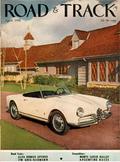The essence of Alfa Romeo is embodied in the Giulietta Spider its delicate and unfussy lines, its handling finesse, the sweet revving nature of the Satta designed 1290 cc engine all add up to an unbeatable package. The clean lines of the body were penned by Pinin Farina with design cues from Alfa Romeo's first monocoque the Alfa Romeo 1900. The simple lines are extenuated by the hood which folds under the rear deck to completely disappear from view. The bright work is simple and understated by standards of the day, the deep Alfa Romeo Grill nestles between the eyebrows of the air intake, the contour of the badge running up to the bonnet are all nice touches.
The interior was simple the seats are comfortable and surprisingly supportive with adjustment of the seatback by means of two small knurled bolts. The steering wheel is large but very tactile the deep baritone horn is operated by pressing the Alfa Romeo steering boss. Through the steering wheel, the instruments are clearly visible and comprehensive with the speedo directly in front, the rev counter to the right and both temperature and fuel gauges to the left. The indicator switch is on the column but the switch-gear for all other control's except the headlamp dip switch are in the centre of the dash. On the passenger side of the dash, there is a cubby hole for oddments and the chrome trim that runs along the lower edge of the dash forms a neat grab handle for the passenger.
Ample power is provided by the 1290 cc engine which comes in two guises, Normale and Veloce. The normale engine produced 80 bhp and its single carb twin-choke carburettor fed the mixture into the engine, which compressed it to 8.5 times its original volume before expelling it through a cast iron manifold. The Veloce had twin carbs, a higher compression ratio at 9.1:1 and a performance exhaust manifold taking the power up to 90 bhp. This gave the Normale a top speed of 165 kmh and the Veloce a top speed of 180 kmh. In order to bring the car to halt Alfa Romeo gave the car drum brakes all round to start with though these were changed to disk brakes on the front with beautiful aluminium finned drums on the rear later in the production run, by modern standards these are heavy but they work well if given a firm push.
Road holding was very good in its day, the front suspension is double unequal length wishbones with an Anti-roll bar, while the rear end has a live rear axle that is securely located by an A-arm that connects to the top of the differential. Springing is by coil springs and the shock absorbers are hydraulic. The steering has a mere 2.8 turns lock to lock and is by worm and roller. To drive, the car feels light and nimble when cruising with the steering weighting up nicely when the car is pushed, driven today the car will have no trouble keeping with the traffic and will surprise many a modern car. Cruising in a Giulietta is a pleasure the wrap around windscreen and small ¼ lights keep the wind off the driver the seating position is comfortable but the steering wheel is quite low and just touches a taller drivers leg. The only slightly clumsy control is the umbrella handbrake but this is only a minor irritation. Looking down the bonnet with the bulges of the wings on either side you can just imagine hurtling up and down Alpine passes the engine eagerly revving all the way to the other side of 7000 rpm, the brakes scrubbing of the speed to get you around the next hairpin. Glorious.
JP
To follow the restoration of our 101 Giulia spider click here
Related Links: Alfa Romeo Twin Cam Engine '54-'97 | Carrozzeria Italian Design Houses


